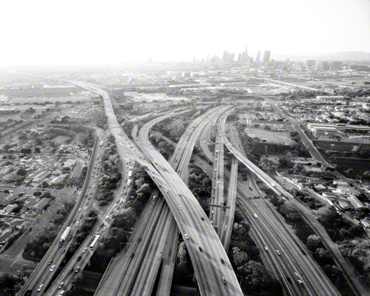LA EXAMINES ITS ARCHITECTURAL HISTORY WITH GETTY’S “OVERDRIVE: L.A. CONSTRUCTS THE FUTURE 1940-1990”
By Eveline Morel | October 7th, 2013 | Category: L.A. Art & Culture | Comments Off on LA EXAMINES ITS ARCHITECTURAL HISTORY WITH GETTY’S “OVERDRIVE: L.A. CONSTRUCTS THE FUTURE 1940-1990”“. . . No city has ever been produced by such an extraordinary mixture of geography, climate, economics, demography, mechanics, and culture; nor is it likely that an even remotely similar mixture will ever occur again. The interaction of these factors needs to be kept in constant historical view – and since it is manifestly dangerous to face backwards while at the steering wheel, the common metaphor of history as the rear-view mirror of civilization seems necessary, as well as apt, in any study of Los Angeles.”
ReynerBanham, Los Angeles: The Architecture of Four Ecologies 1971.
The recent “rear-view mirror” look at Los Angeles’s urban development proposed by the Getty Research Institute explores its architectural legacy, as it attempts to reframe the public’s perception of Los Angeles as a model of urban chaos, espousing instead that the city’s development was the result of a planned and deliberate endeavor to deal with the extraordinary pace of economic and population growth. Aptly entitled “Overdrive: L.A. Constructs the Future 1940-1990,” the exhibit and accompanying book are part of Pacific Standard Time Presents: Modern Architecture in L.A. This is one of the many initiatives spearheaded by the Getty Trust to analyze and document the city’s architectural landscape and urban environment, in collaboration with other civic and cultural institutions, and building upon the work of historians, theorists, critics, and activists, whose introspective writings and research have examined the city’s development.
 As the nation’s second largest city, Los Angeles is one of the few cities in the U.S. to have continuous growth since the 1950s. Over the five decades between 1940 and 1990, Los Angeles exploded into one of the most populous and most influential industrial, economic, and creative capitals of the world, experiencing its biggest growth spurt in only two decades, 1940-1960, where its population rose by 65%. The city became a laboratory for cutting-edge design and architectural innovation as urban planners and architects undertook architectural and urban planning experiments to deal with the city’s exploding population.
As the nation’s second largest city, Los Angeles is one of the few cities in the U.S. to have continuous growth since the 1950s. Over the five decades between 1940 and 1990, Los Angeles exploded into one of the most populous and most influential industrial, economic, and creative capitals of the world, experiencing its biggest growth spurt in only two decades, 1940-1960, where its population rose by 65%. The city became a laboratory for cutting-edge design and architectural innovation as urban planners and architects undertook architectural and urban planning experiments to deal with the city’s exploding population.
Although Los Angeles is consistently accused of developing without intention or order, the Getty exhibit and book argue that the apparent randomness and chaos of the region’s rapid expansion is actually the product of thoughtful, concerted efforts undertaken by powerful alliances, vested industrial and political interests at local and national level, enlightened patrons and urban visionaries, and innovative designers.
The over-abundance of materials presented in the book and exhibit closely examine the various aspects of the urban growth during this period. Structured into five broad topical sections instead of a chronological or architect-based organization, the exhibit attempted to present a more thematic approach to its survey of LA urban history.
The first section, titled “Urban Networks,” explores the city’s robust water and power infrastructures and vast transportation network, which allowed the region to grow at an unprecedented pace. The main factors that made this expansion possible are the technological and infrastructure advances that supplied urban areas with water and electricity, and the freeway transportation system that contributed to the horizontal expansion of the city.
The “Car Culture” section shows how the automobile aesthetic and cultural attitudes have become inextricably linked to L.A.’s global identity, giving rise to new buildings geared towards a motorized population: shopping malls, gas stations, drive-in theaters, and eye-popping coffee shops. The “Engines of Innovation” section demonstrates how the region’s influx of capital, materials, and skilled labor, together with visionary patrons and global leaders, provided new avenues for architectural creativity. The two other sections “Community Magnets” and “Residential Fabric” explore various approaches used by architects and urban planners to deal with the architectural challenges of creating public spaces, and presents unique insights into the region’s influential residences, from modernist homes to massive housing developments.
By the mid-twentieth century, Los Angeles stood at the very center of the new culture and economy of post-war America, the template for post-World War II automobile-driven urban growth, the ideal representation of the “consumer paradise for the masses,” thanks to the new aerospace technologies, oil-burning automobiles, and the architectural aesthetic inspired by the materials and technologies of a modern age.
The war-industry boom fueled by aircraft and ship-building, together with the movie industry, combined to create an unprecedented demand for housing that could be rapidly and efficiently constructed. In the years following the Great Depression, government programs restructured the lending industry so renters could become buyers. During the post-war period, the Defense industries were prepared to repurpose their production into home building, and experiments in construction and delivery presented ways in which housing could be mass-produced. And the Los Angeles area’s advanced auto-oriented infrastructure made it possible to build homes in the inexpensive outlying land. The highway construction that started in the mid-50s and continued throughout the 60s to the early 70s further contributed to the city’s horizontal expansion and shaped its mobile lifestyle.
The variety of materials amassed by the Getty Research Institute is remarkable, as is the attempt to create a cohesive structure for examining one of the most decisive periods in the city’s urban history. Forcing the viewer to shift into mental “overdrive” to process the vast amounts of historical data, video recordings, architectural models, drawings, photos, and interviews all crammed into the exhibit drove the point home: a lot happened during these five decades! It all comes together, though, as you walk outside the museum and look down the hill to the crowded 405 Freeway, to downtown in the east, and to the ocean in the west. L.A. in all its beauty, chaos, and dynamic movement stretches out before your eyes, and you become a part of its ever-evolving history.








